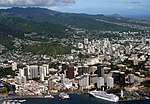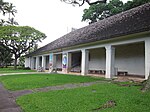National Memorial Cemetery of the Pacific
1949 establishments in HawaiiBuildings and structures in HonoluluCemeteries on the National Register of Historic Places in HawaiiCultural infrastructure completed in 1949Historic American Landscapes Survey in Hawaii ... and 11 more
Korean War memorials and cemeteriesMonuments and memorials in HawaiiMonuments and memorials on the National Register of Historic Places in HawaiiNational Register of Historic Places in HonoluluProtected areas of OahuTourist attractions in HonoluluUnited States in the Korean WarUnited States national cemeteriesUse mdy dates from February 2012World War II cemeteriesWorld War II memorials in the United States

The National Memorial Cemetery of the Pacific (informally known as Punchbowl Cemetery) is a national cemetery located at Punchbowl Crater in Honolulu, Hawaii. It serves as a memorial to honor those men and women who served in the United States Armed Forces, and those who have given their lives in doing so. It is administered by the National Cemetery Administration of the United States Department of Veterans Affairs and is listed on the National Register of Historic Places. Millions of visitors visit the cemetery each year, and it is one of the most popular tourist attractions in Hawaii.
Excerpt from the Wikipedia article National Memorial Cemetery of the Pacific (License: CC BY-SA 3.0, Authors, Images).National Memorial Cemetery of the Pacific
Mall Drive South, Honolulu Makiki Kai
Geographical coordinates (GPS) Address Nearby Places Show on map
Geographical coordinates (GPS)
| Latitude | Longitude |
|---|---|
| N 21.312777777778 ° | E -157.84638888889 ° |
Address
Mall Drive South
Mall Drive South
98622 Honolulu, Makiki Kai
Hawaii, United States
Open on Google Maps








